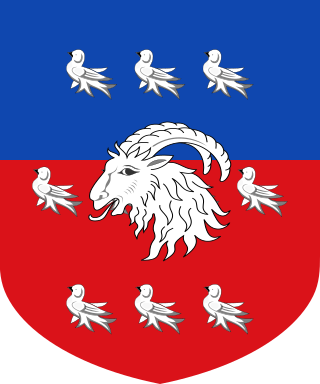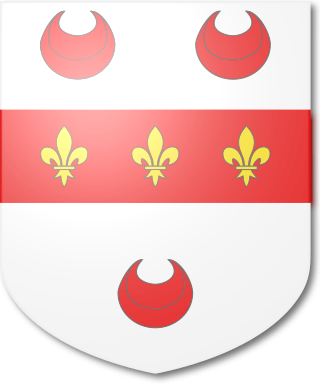
Viscount Hardinge, of Lahore and of Kings Newton in the County of Derby, is a title in the Peerage of the United Kingdom. It was created in 1846 for the soldier and Tory politician Sir Henry Hardinge. His son, the second Viscount, represented Downpatrick in Parliament. His great-great-grandson, the sixth Viscount, succeeded a distant relative as eighth Baronet, of Belle Isle in the County of Fermanagh, in 1986. This title had been created in the Baronetage of the United Kingdom 1801 for Richard Hardinge. He was the third son of Nicolas Hardinge, younger brother of Reverend Henry Hardinge and uncle of the latter's third son Henry Hardinge, 1st Viscount Hardinge. The baronetcy was created with special remainder to the heirs male of Richard Hardinge's father.

Baron Avebury, of Avebury in the County of Wiltshire, is a title in the Peerage of the United Kingdom. It was created 22 January 1900 for the banker, politician and archaeologist Sir John Lubbock, 4th Baronet. He was succeeded by his eldest son, the second Baron. On his death the titles passed to his nephew, the third Baron. He was the son of Harold Fox Pitt Lubbock, fourth son of the first Baron, who died in 1971. The title then passed to the third Baron's first cousin, the fourth Baron, the son of Maurice Fox Pitt Lubbock, sixth son of the first Baron. The fourth baron was a Liberal Democrat politician and one of the ninety excepted hereditary peers who remained in the House of Lords after the passing of the House of Lords Act 1999. He was succeeded by his son, the fifth Baron, in 2016.
The Duffbaronetcy, of Halkin in the County of Aberdeen, is a title in the Baronetage of the United Kingdom. It was created on 12 November 1813 for James Duff, British Consul in Cádiz, with remainder to his nephew, William Gordon.

The Cooper, later Paston-Cooper, later Astley-Cooper Baronetcy, of Gadebridge in the County of Hertford, is a title in the Baronetage of the United Kingdom. It was created on 31 August 1821 for the noted surgeon and anatomist Astley Cooper, with remainder, in default of male issue, to his nephew Astley Paston Cooper, third son of his elder brother Reverend Samuel Lovick Cooper, who succeeded as second Baronet in 1841. The third and fourth Baronets used the surname of Paston-Cooper. The sixth Baronet used the surname of Astley-Cooper, which is also used by the seventh Baronet and present holder of the title.

The Broadbent Baronetcy, of Longwood in the Parish of Huddersfield in the West Riding of the County of York, and of Brook Street, in the Parish of St George Hanover Square in the County of London, is a title in the Baronetage of the United Kingdom. It was created on 10 August 1893 for the noted physician William Broadbent, personal physician to Queen Victoria. The title descended from father to son until the death of his grandson, the third Baronet, in 1987. The late Baronet was succeeded by his first cousin once removed, the fourth Baronet. He was the grandson of Walter Broadbent, third son of the first Baronet.

The Boord Baronetcy, of Wakehurst Place in the County of Sussex, is a title in the Baronetage of the United Kingdom. It was created on 18 February 1896 for the Conservative politician Thomas Boord. His eldest son, the second Baronet, died unmarried in 1928 and was succeeded by his nephew, the third Baronet. He was the son of Alexander Edgar Boord, third son of the first Baronet. The third Baronet's eldest son, the fourth Baronet, succeeded in 1975. On his death in 2019, the title passed to his nephew Andrew, an Istanbul-based translator and business development consultant.

The Hammick Baronetcy, of Cavendish Square, London, is a title in the Baronetage of the United Kingdom. It was created on 25 July 1834 for the noted surgeon and physician Stephen Hammick.

The Oakeley Baronetcy, of Shrewsbury, is a title in the Baronetage of Great Britain. It was created on 5 June 1790 for the Indian administrator Charles Oakeley. He served as Governor of Madras from 1790 to 1794. Frederick Oakeley was the second son of the first Baronet.

The Leeds Baronetcy, of Croxton Park in the County of Cambridge, is a title in the Baronetage of the United Kingdom. It was created on 31 December 1812 for George Leeds. He was an equerry to Prince Augustus Frederick, Duke of Sussex. The Croxton Park estate in Cambridgeshire had been in the Leeds family since circa 1568. As of 2011 the presumed ninth and present Baronet, a resident of Canada, has not successfully proven his succession and is not on the Official Roll of the Baronetage.

The Wedderburn, later Ogilvy-Wedderburn Baronetcy, of Balindean in the County of Perth, is a title in the Baronetage of the United Kingdom created in 1803.

The Beresford, later Beresford-Peirse Baronetcy, of Bagnall in the County of Waterford, is a title in the Baronetage of the United Kingdom. It was created on 21 May 1814 for John Beresford. He was an admiral in the Royal Navy and also represented Coleraine, Berwick-on-Tweed, Northallerton and Chatham in the House of Commons.

The Milman Baronetcy, of Levaton-in-Woodland in the County of Devon, is a title in the Baronetage of Great Britain. It was created on 28 November 1800 for Francis Milman, Physician-in-Ordinary to King George III and President of the Royal College of Physicians. The seventh Baronet was a brigadier-general in the British Army.

The Dalrymple-Horn-Elphinstonebaronetcy, of Horn and of Logie Elphinstone in the County of Aberdeen, is a dormant title in the Baronetage of the United Kingdom. It was created on 16 January 1828 for Robert Dalrymple-Horn-Elphinstone. He was the grandson of Hew Elphinstone, second son of Hew Dalrymple, Lord North Berwick, third son of James Dalrymple, 1st Viscount of Stair. The second Baronet sat as Member of Parliament for Portsmouth. The fifth Baronet assumed the surname of Elphinstone-Dalrymple. The title became either extinct or dormant on the death of the seventh Baronet in 1956.

The Fleming, later le Fleming Baronetcy, of Rydal in the County of Westmorland, is a title in the Baronetage of England. It was created on 4 October 1705 for William Fleming, Member of Parliament for Westmorland. The second Baronet was Bishop of Carlisle. The third Baronet represented Cumberland in the British House of Commons. The fourth Baronet was Member of Parliament for Westmorland. He assumed the surname of le Fleming, an ancient version of the family surname. This version of the surname has also been borne by the Baronets from the seventh Baronet onwards. The sixth Baronet, an ordained priest, served as Rector of Windermere.
The Domville Baronetcy, of St Alban's in the County of Hertford, was a title in the Baronetage of the United Kingdom. It was created on 28 July 1814 for William Domville, Lord Mayor of London from 1813 to 1814. He was a descendant of William Domville, elder brother of Gilbert Domvile, ancestor of the Domvile baronets of Tempoleogue. The title became extinct on the death of the seventh Baronet in 1981.
The Hon. Francis Grosvenor Hood (1809–1855) was an English army officer in the British Army, rising to the rank of lieutenant-colonel of the Grenadier Guards. He led, as major, the 3rd Battalion of Grenadiers at the Battle of the Alma in 1854. He was killed in the trenches before Sebastopol in 1855.
The Curtis baronetcy, of Cullands Grove, Southgate in the County of Middlesex, was created in the Baronetage of the United Kingdom on 23 December 1802 for Sir William Curtis, 1st Baronet, the son of a wealthy London biscuit manufacturer. He was member of parliament for the City of London from 1790 to 1818 and 1820 to 1826 and Lord Mayor of London from 1794 to 1795. He was later offered a peerage but declined. The third Baronet moved the family seat to Caynham Court, Caynham, Shropshire in 1852 and was High Sheriff of Shropshire in 1857. The fourth and fifth Baronets were both succeeded by cousins. The Shropshire estate was sold following the death of the sixth Baronet. The family seat is now at Bishops Waltham, Hampshire

The Bateman baronetcy, of Hartington in the County of Derby, was created in the Baronetage of the United Kingdom on 13 December 1806 for Hugh Bateman. The Batemans of Hartington Hall were the senior branch of the family; Sir Hugh had no sons, so the baronetcy was created with a special remainder allowing the male heirs of his two daughters to succeed. On 14 February 1815 his elder daughter Catherine Juliana married Edward Scott, and on 3 August the same year his younger daughter Amelia Anne married Sir Alexander Hood, 2nd Baronet, of St Audries.

The Croft baronetcy, of Cowling Hall in the County of York, was created in the Baronetage of the United Kingdom on 17 December 1818 for John Croft, for his services during the Peninsular War. He shared a common ancestry with the Croft baronets of Croft Castle.

The Forbes baronetcy, of Craigievar in the County of Aberdeen, was created in the Baronetage of Nova Scotia on 20 April 1630 for William Forbes, son of the merchant William Forbes who built Craigievar Castle. He was also a descendant of Hon. Patrick Forbes, third son of the 2nd Lord Forbes, and the nephew of the 1st Baronet of the 1628 creation.
















